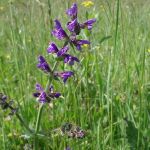
|
| Muscatel Sage |
A genus of some 900 species of mostly aromatic annuals, biennials, perennials, and mainly evergreen shrubs and subshrubs, found worldwide in temperate, subtropical, and dry tropical areas. They favor dry, stony, or rocky hillsides, scrub, and meadows, almost always in open, sunny places. Salvias have interesting and diverse aromas, textures, and colors, and their flowers secrete abundant nectar, making them locally important as bee plants. Over 100 species and many variants are available as ornamentals, some of which have medicinal and culinary uses. They are rewarding plants to grow, since they have a long flowering period and combine well with many other kinds of garden plants. Few make good cut flowers, the exceptions being S. sclarea and S. viridis, which are excellent both fresh and dried. The hardiest and most widely used species is common sage, S. officinalis, which has been cultivated in N Europe since medieval times, and was introduced to N America in the 17th century. The Romans used it to increase fertility, and its medicinal uses were mentioned by Theophrastus, Dioscorides, and Pliny. Known as Salvia salvatrix ("sage the savior"), its reputation for promoting longevity began in Classical times, giving rise to sayings such as "he that would live for aye [ever], must eat sage in May". The name of this genus also reflects this, bring from the Latin salvere, "to be well". Sages are rich in volatile oils, which vary greatly from species to species. Salvia officinalis contains a camphoraceous oil, consisting of about 50 percent thujone. In excess, this compound is hallucinogenic, addictive, and toxic. Salvia fruticosa has less thujone and S. lavandulifolia has none. Salvia offinalis also contains rosmarinic acid, which has the effect of stopping perspiration within about two hours of the correct dose being given. Dried sage is popular in the kitchen, and commercial dried sage may include leaves of S. fruticosa, S. lavandulifolia, and S. pomifera as well as S. officinalis. Meadow sage (S. pratensis) has also been used as a substitute for common sage, and as a flavoring for beer and wine. Salvias are numerous in western N America and C America, and many are used locally for flavoring. Many species have bright red or yellow flowers that are pollinated by hummingbirds. Several species are valued for their seeds, which ehwn soaked in water form a gelatinous mass that forms the basis for refreshing drinks. Examples are S. columbariae (golden chia) and S. tiliaefolia (Tarahumara chia, lindenleaf sage), whose nutritious seeds are also used for sprouting, or ground as a baking ingredient, while the aromatic foliage is used for flavoring and teas. Other interesting American salvias include: S. apiana(white sage), a pungently aromatic species that was used in smudging ceremonies by native tribes, and has nutritious chia-type seeds; S. lyrata (cancerweed, lyre-leafed sage) which is used in folk medicine for colds, coughs, asthma, and cancer, and as a dressing for warts, wounds, and sores; S. mellifera (black sage), used by settlers for tea and flavoring; and S. microphylla syn. S. grahamii (Graham's sage, red bush), whose flowers and minty leaves are infused to treat fevers. S Africa has a number of salvias that have long been used for their disinfectant, healing, and aromatic properties. Salvia africana syn. S. africana-caerulea (blue sage, blousalie) was found by Dutch settlers to be a good substitute for common sage, in terms of home remedies and teas. The creeping or small sage, S. repens, has little to recommend it for cooking, but is much used locally as a tea for bronchial infections and digestive problems, or a wash for infected wounds or sores. It is also burned to disinfect homes after illness, and to deter insect pests in the home. Similar medicinal uses are recorded for S. aurea (brown sage, dune sage), S. disermas (Transvaal sage, groot salie), S. stenophylla (narrow-leaf sage, fynblaar salie) and S. verbenaca (vervain sage, Free State sage, vrystaat salie). In China, the main species used is S. miltiorhiza, known as dan shen, red sage, or red ginseng because of its red roots; it was recorded as an important medicinal herb in 206BCE. Two other species are used as sources of the drug da shen: S. bowleyana (southern dan shen; and S. przewalskii (Gansu dan shen), while various other species are used in folk medicine as "folk dan shen".
Hairy perennial or biennial with strongly aromatic, light green, deeply veined, broadly ovate, leaves, to 23cm (9in) long, which have indented margins. Whorls of bicolored cream and lilac to pink or blue flowers, to 3cm (1¼in) long, with conscpicuous lilac bracts, appear in spring and summer.
|
||
A bitter, astringent, warming herb with mucilaginous seeds and a vanilla-balsam aroma. It relaxes spasms, aids digestion, stimulates the uterus and estrogen production, calms nerves, controls vomiting, and is reputedly aphrodisiac. |
||
|
||
Magical Aromatherapy by Scott Cunningham Copyright © 1989 Llewellyn Publications, Inc. Pp 75-76 The Encylopedia of Herbs by Deni Bown Copyright © 1995, 2001 Dorling Kindersley Limited. Pp.353-356 | ||